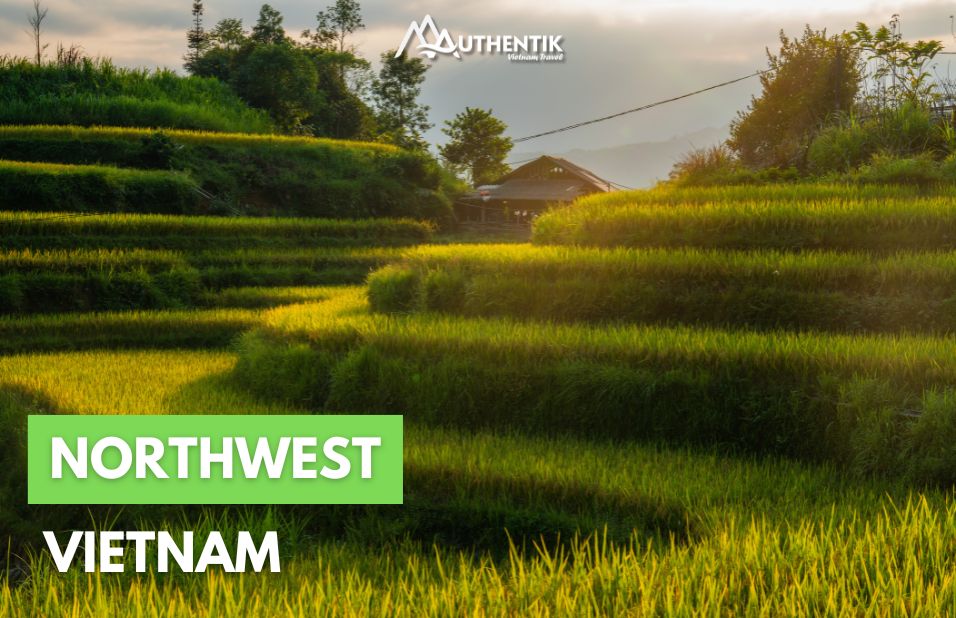
Tour in the Northwest Vietnam: Where to go? Which itinerary? What to do? How many days?
- on Nov 8, 2023 By: Ngoc Tu DINH
Northwest Vietnam is a stunning realm of rugged mountains and lush landscapes, captivating adventurous spirits and nature lovers alike. This enchanting region boasts emerald rice terraces, ancient traditions, and vibrant hill tribes, where every encounter tells a story.
Explore the striking contrasts—serene valleys meet towering cliffs, and bustling markets pulse with life against tranquil backdrops. Whether trekking through misty vistas or savoring local delicacies, each moment promises a thrilling experience.
Discover the magic of Northwest Vietnam, where every corner reveals new wonders and adventures waiting to unfold!
Northwest Vietnam: The Land of the Most Stunning Terraced Rice Fields of Vietnam
Traveling in Northwest Vietnam means immersing yourself in one of the most sumptuous terraced rice fields and rice-growing valleys of the country. Just three hours from Hanoi, Mai Chau and Mai Hich offer a stunning natural spectacle, where the green hues of rice fields contrast with the majestic limestone mountain ranges. From the Thung Khe Pass, an awe-inspiring panorama opens up over the Mai Chau Valley: a patchwork of sparkling rice fields, dotted with authentic hamlets and graceful palm trees. Northwest Vietnam is home to treasures where valleys of rice fields stretch endlessly. Two of these valleys stand out in particular: Dien Bien Phu and Nghia Lo.
Dien Bien Phu: A Place of Memory and Vast Rice Fields
Three syllables that still resonate in history: Dien Bien Phu. This valley, the largest in the region, was the site of a decisive battle that ended French presence in Indochina. Today, Dien Bien Phu reveals itself as a vast rice granary of the north, where you can explore historical remains scattered amid these fertile landscapes.
Nghia Lo: Gateway to Spectacular Terraced Rice Fields
A little further north, Nghia Lo, the second-largest rice valley in the northwest, offers a gateway to the spectacular terraced rice fields. From the sky, it looks like a giant pan encircled by mountains draped in clouds year-round. This land is the birthplace of the Black Thai, a people who have lived here for centuries, enriching the region with their fascinating culture.
From Tu Le to Mu Cang Chai, the Legendary ‘Photographers’ Route’
Head towards Tu Le, a hidden gem nestled between three mountain ranges—Khau Pha, Khau Song, and Khau Than. Renowned for its stunning cascading rice terraces and famous fragrant sticky rice, this valley is especially enchanting from August to October, when the fields turn a golden hue. Then, follow the legendary ‘Photographers’ Route’, a 100-kilometer journey leading to Mu Cang Chai, the paradise of terraced rice fields sculpted by generations of farmers. Depending on the season, the landscape transforms:
- April to May: The flooded rice fields become giant mirrors, reflecting the sky and surrounding peaks.
- September to October: They reach their peak, offering a vibrant blend of bright greens and flaming golds under an azure sky.
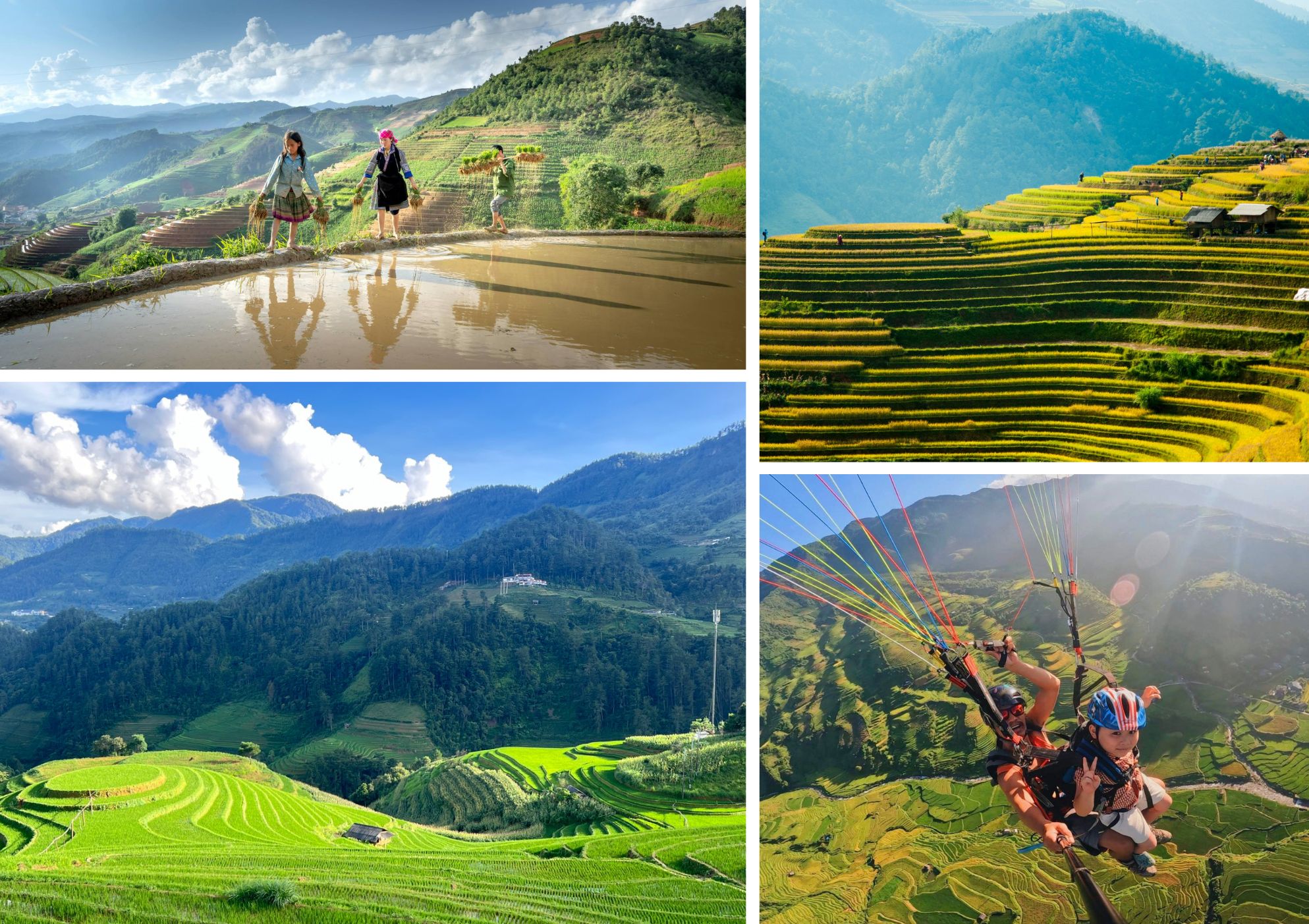
The iconic villages of La Pan Tan, De Xu Phinh, and Che Cu Nha are must-see stops for admiring these natural amphitheaters and experiencing an authentic immersion. Less touristy and close to the Chinese border, the town of Y Ty also unveils fabulous patches of cascading rice fields from the mountains.
Sapa: The Gem of Mountains and Ethnic Minorities
Continue your ascent north to reach Sapa, a former colonial hill station and sanctuary for the region’s most spectacular terraced rice fields. Nestled over 1,500 meters above sea level, it attracts trekking lovers and photographers alike with its unforgettable panoramas and encounters with the minority ethnic groups.
The trails, suitable for all levels, cross through traditional villages where time seems to stand still. Between March and May, and from July to early December, Sapa unveils its full splendor, with landscapes changing throughout the seasons.
Whether you’re passionate about history, a photography lover, or seeking an escape into nature, Northwest Vietnam promises an unforgettable adventure, where each valley tells a story and every rice field holds a legend.
Northwest Vietnam: a land of exploration and contrasting landscapes
Northwest Vietnam is characterized by its rugged terrain, composed of rice valleys, mountain ranges, and high plateaus. This variety of landscapes makes it an ideal place for hiking and exploration. The trails range from paths suitable for casual walkers to more demanding ascents. Among the region’s iconic peaks, Fansipan, the highest point in Vietnam at 3,143 meters, represents a challenge for trekkers aiming to reach the “roof of Indochina.”

Navigation and Water Systems of the Northwest
In addition to its rugged terrain, the region is home to two of Vietnam’s largest artificial lakes, which play a significant role in the local ecosystem and offer opportunities for navigation.
The Hoa Binh Reservoir, created by the largest hydroelectric dam in the country, stretches at the foot of the karst formations of its namesake province. Its calm waters, surrounded by tropical forests, form a transport corridor for the local minorities and a kayaking haven, offering a quiet approach to wildlife and flora.
The Thac Ba Lake, created by a dam on the Chay River, covers 23,400 hectares and stretches over 80 kilometers. Its network of rocky islands and submerged hills fosters a mild microclimate, keeping temperatures moderate in summer. This lake feeds the surrounding rice fields and serves as an essential fishing basin for local populations. Kayaking in these waters offers a unique opportunity to observe traditional lifestyles, especially in the floating villages.
A Region Shaped by Natural and Human Dynamics
Northwest Vietnam is where erosion-sculpted landscapes meet infrastructure designed for agriculture and hydroelectricity. Between terraced rice fields, shaped over centuries, and artificial bodies of water transformed into communication routes, the region illustrates the adaptation of the local populations to a challenging environment. Its hiking trails and lake zones provide privileged spaces for observing the interaction between man and nature.
Encounter with the Mountain Peoples
Long isolated, North-West Vietnam is a true ethnic melting pot, where communities with ancient traditions live side by side.
A Crossroad of Cultures and Histories
Formerly known as the land of Thai, this territory has historical roots in the Thai federation of lords, founded in 1640, which was later recognized by the Chinese, Annamite, and French colonial dynasties. The Thai people, strategic allies of the French during the Indochina War, were the first to settle in the fertile valleys of the region. Today, they share this space with other ethnic groups such as the Mong, Dao, Dzay, Lu, and Muong, forming a rich and vibrant cultural fabric.
Ethnic Markets: Hubs of Exchange and Tradition
Traveling through the Northwest means diving into the deep-rooted traditions of these ethnic minorities. The weekly markets are not only places of commerce but real social events where each community gathers to exchange, forge connections, and celebrate its identity. These markets are also the perfect opportunity to admire traditional costumes, which are true textile masterpieces handmade by the locals.
Here’s an overview of the must-visit ethnic markets, spread throughout the week:
Sapa: Daily market in the town center
Tuesday: Coc Ly Market (Bac Ha, Lao Cai)
Wednesday: Cao Son Market (Muong Khuong, Lao Cai) and Sin Cheng Market (Si Ma Cai, Lao Cai)
Thursday: Lung Khau Nhin Market (Muong Khuong, Lao Cai)
Saturday: Can Cau Market (Si Ma Cai, Lao Cai) and Pha Long Market (Muong Khuong, Lao Cai)
Sunday: Iconic markets of Bac Ha, Muong Khuong, Muong Hum, Lung Phin (Ha Giang), and Dong Van (Ha Giang)
Staying with Locals: An Authentic Immersion
Beyond the markets, the Northwest of Vietnam can be fully discovered by sharing the daily life of the locals. There are numerous opportunities for homestays, offering a unique immersion into traditional lifestyles. Spending a few days in a stilt house, learning weaving techniques, or participating in agricultural work provides meaningful travel experiences.
In this region, shaped by both history and cultural diversity, every encounter opens a window into a preserved way of life, where hospitality and traditions continue across generations.
Best time to visit Northwest Vietnam
Northwest Vietnam offers spectacular landscapes that change with the seasons, but not all seasons are ideal for exploration. To ensure a successful trip, it’s essential to choose the right travel time. If you are planning on a trip to Northwest Vietnam, here is what you should know about the weather.
Spring and Fall: Ideal Times to Travel to Northwest Vietnam
April, May, June, September, and October are the best months to discover the region.
- In April and May, the sun is shining, and the rice fields begin to turn green before reaching their golden peak at the end of May, just before the first harvest in the valleys.
- In September and October, the terraced rice fields, especially in higher regions like Mu Cang Chai or Hoang Su Phi, offer a stunning spectacle of golden cascades ready for the annual harvest.
Summer (July-August): Heat and Contrasts
Summer is a contrasting season, featuring hot temperatures during the day and intense thunderstorms in the afternoon. However, this is also when the rice fields are at their most vibrant green, offering a spectacular view before turning golden in September. If the heat doesn’t bother you and you’re prepared for a few tropical showers, this season remains an intriguing option.
Winter (December to March): Unfavorable Time
From December to late March, the weather can be harsh. Cold temperatures, damp conditions, light rain, and dense fog can limit visibility and make hiking uncomfortable. The landscapes, often shrouded in mist, lose some of their vibrancy, and some mountain roads may become slippery and difficult to navigate.
Best Itinerary Ideas to Explore Northwest Vietnam
With a minimum of 5 days, embark on a wonderful loop through North-West Vietnam, a region full of natural, cultural, and human treasures. Planning a tour in North-West Vietnam? Here are some of best Northwest Vietnam travel itineraries, curated by Authentik Vietnam, that promise to treat you with breathtaking landscapes of terraced rice fields, lively ethnic market, and fascinating enounters.
5-Day Itinerary
Starting from Hanoi, embark on a journey off the beaten path to explore North-West Vietnam. Your adventure begins in the Nghia Lo Valley, where stunning terraced rice fields offer a breathtaking spectacle. Along the way, stop in traditional villages to meet locals wearing vibrant costumes and discover their authentic way of life.
Continue your journey to Mu Cang Chai, a region known for some of the most spectacular rice terraces in Vietnam. This territory, steeped in the unique culture of indigenous peoples, is a true source of inspiration for photographers from around the world.
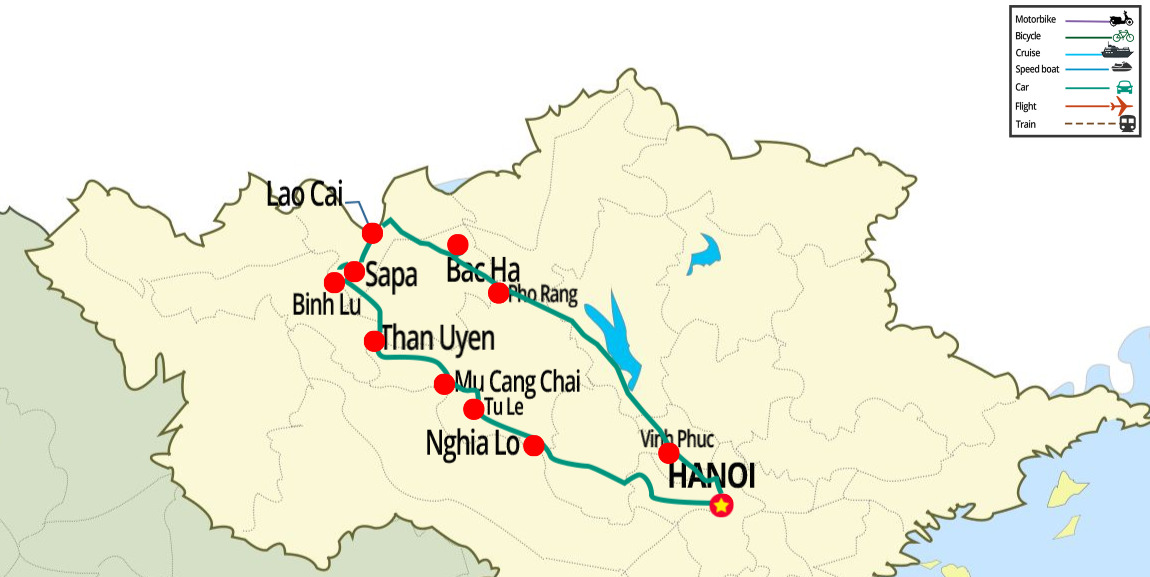
Itinerary:
Hanoi – Nghia Lo – Tu Le – Mu Cang Chai – Sapa – Bac Ha – Hanoi
Day 1: Hanoi – Nghia Lo
Day 2: Nghia Lo – Tu Le – Mu Cang Chai
Day 3: Mu Cang Chai – Sapa
Day 4: Sapa – Bac Ha
Day 5: Bac Ha – Hanoi
If you have extra time, extend your stay in Mu Cang Chai for a day to further explore the region.
8-Day Itinerary
This itinerary takes you deep into the North-West, far from the world’s hustle and bustle, for a complete immersion in landscapes that will leave you breathless. From Nghia Lo to Sapa, through Dien Bien Phu and Mu Cang Chai, you’ll pass through magnificent valleys and admire stunning rice terraces from new perspectives.
This trip promises great discoveries and unforgettable encounters with people from remote villages, for a truly authentic and immersive experience!
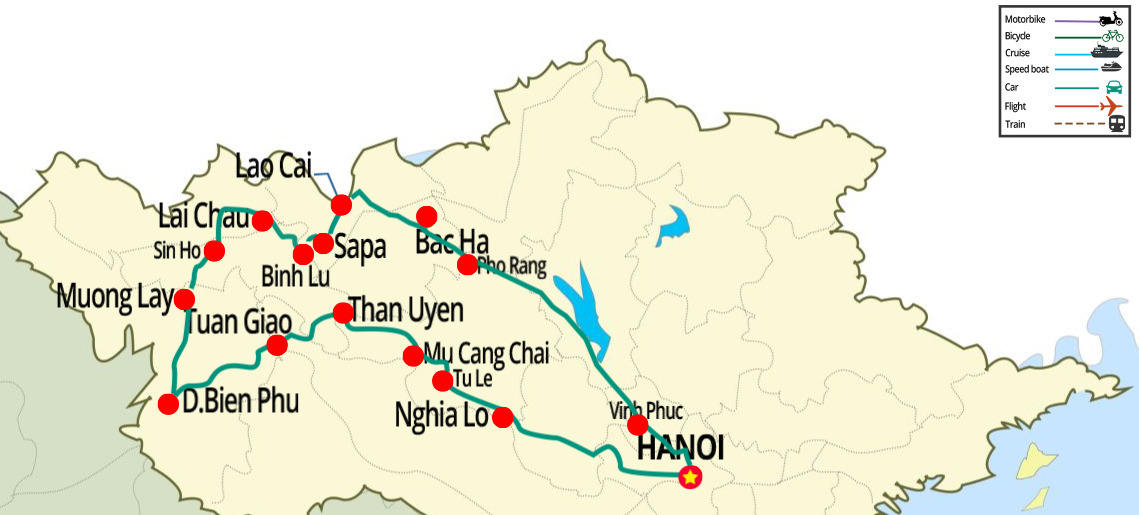
Itinerary:
Hanoi – Nghia Lo – Tu Le – Mu Cang Chai – Sapa – Dien Bien Phu – Lai Chau – Sapa – Bac Ha – Hanoi
Day 1: Hanoi – Nghia Lo
Day 2: Nghia Lo – Tu Le – Mu Cang Chai
Day 3: Mu Cang Chai – Trekking
Day 4: Mu Cang Chai – Lai Chau
Day 5: Lai Chau – Dien Bien Phu
Day 6: Dien Bien Phu – Sapa
Day 7: Sapa – Bac Ha
Day 8: Bac Ha – Hanoi
9-Day Itinerary
This itinerary suggests exploring the North-West of Vietnam in reverse. Starting from Hanoi, dive into the lands of ethnic minorities, beginning with Bac Ha, Sapa, and Dien Bien Phu.
Continue your adventure in Mu Cang Chai, where you’ll be amazed by the spectacular rice terraces, resembling immense ladders connecting the earth to the sky. For a total immersion, a trek through villages and an overnight stay with the locals is highly recommended.
Finish your journey in Nghia Lo, where the Thai people proudly preserve their culture, traditions, and way of life.
Itinerary:
Hanoi – Bac Ha – Sapa – Lai Chau – Dien Bien Phu – Mu Cang Chai – Tu Le – Nghia Lo – Hanoi
Day 1: Hanoi – Bac Ha
Day 2: Bac Ha – Sapa
Day 3: Sapa – Discovery
Day 4: Sapa – Dien Bien Phu
Day 5: Dien Bien Phu – Lai Chau
Day 6: Lai Chau – Mu Cang Chai
Day 7: Mu Cang Chai – Discovery
Day 8: Mu Cang Chai – Tu Le – Nghia Lo
Day 9: Nghia Lo – Hanoi
Combined North-West and North-East Itinerary
From North-West to North-East, embark on an unforgettable journey through the most scenic panoramic roads in northern Vietnam. Over 3,000 kilometers, this circuit will take you through the legendary “four great passes” and reach the far west and north of the country.
Along the way, explore over ten iconic sites, including Mù Cang Chai, Sapa, Hà Giang, and the majestic Ban Gioc Waterfall. Starting from Hanoi, this adventure connecting the North-West to the North-East promises breathtaking landscapes, winding roads, and exceptional discoveries. A one-of-a-kind experience not to miss!
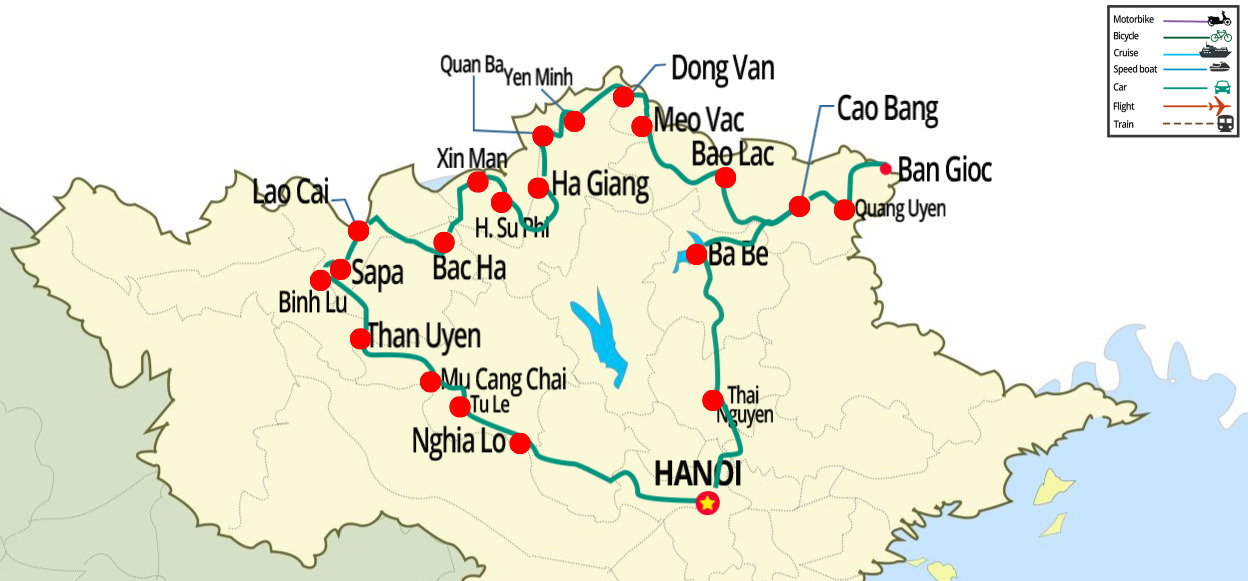
Itinerary:
Hanoi – Nghia Lo – Tu Le – Mu Cang Chai – Sapa – Bac Ha – Ha Giang – Dong Van – Meo Vac – Bao Lac – Cao Bang – Ba Be
Day 1: Hanoi – Nghia Lo
Day 2: Nghia Lo – Tu Le
Day 3: Tu Le – Mu Cang Chai (Suggest: You can add 1-2 extra days in Mu Cang Chai)
Day 4: Mu Cang Chai – Sapa (Suggest: You can add 1-3 extra days for trekking in Sapa)
Day 5: Sapa – Bac Ha
Day 6: Bac Ha – Xin Man – Ha Giang (Suggest: You can add 1 day extra for trekking in Ha Giang)
Day 7: Ha Giang – Quan Ba – Yen Minh – Dong Van
Day 8: Dong Van – Meo Vac – Bao Lac
Day 9: Bao Lac – Cao Bang
Day 10: Cao Bang – Ban Gioc – Cao Bang
Day 11: Cao Bang – Ba Be
Day 12: Ba Be – Hanoi
If you need any further advice regarding your trip to Vietnam, don’t hesitate to email us at: info@authentikvietnam.com or send us a request via this formHERE.
Related articles:
>> Best Time to Visit Vietnam: A detailed weather guide
>> Vietnam Tour 2024-2025: Where to go? Which itinerary? What to do? How many days?
 Español
Español Français
Français







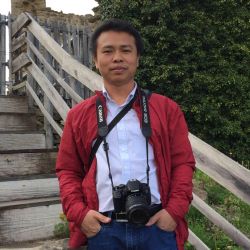
.jpg)
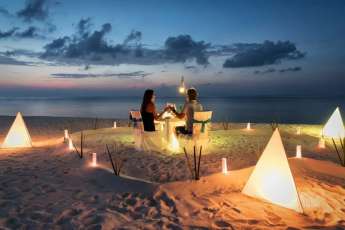
.jpg)
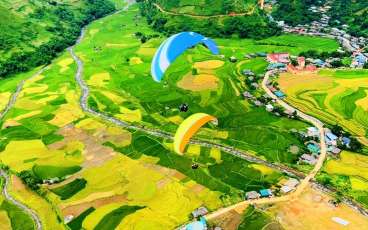









Morgane Ter Cock
on Dec 18, 2025HerbertPhomaMS
on Oct 19, 2025Lilyan Cuttler
on Oct 15, 2025Avenue17XC
on Sep 14, 2025Avenue18JL
on Jul 21, 2025